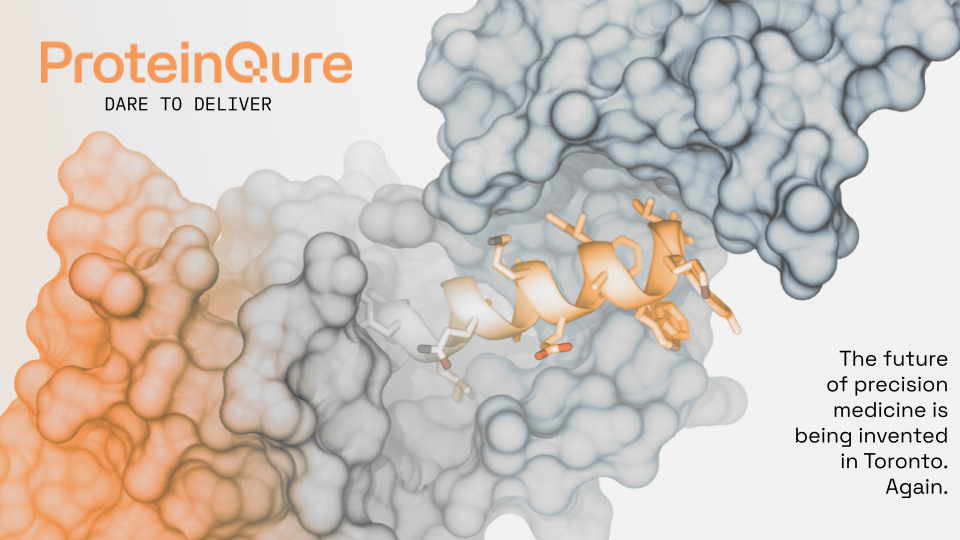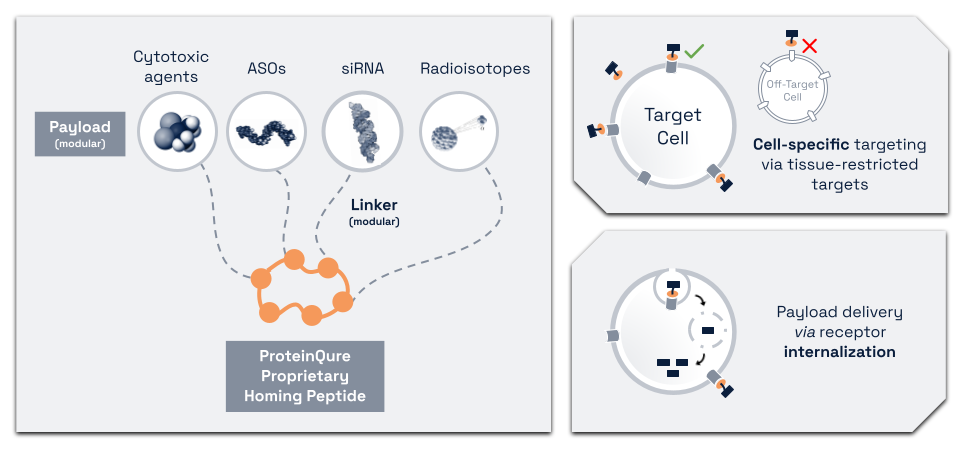ProteinQure – Dare to Deliver

Toronto has been home to the biggest breakthroughs in peptide therapeutics.
In 1921, Banting and Best discovered the first major peptide therapeutic insulin.
Nearby, in 1984, Dan Drucker discovered glucagon-like peptide 1 (GLP-1), the predecessor to the blockbuster Ozempic.
In 2018, just across the street from these other discoveries, ProteinQure was founded. Since our first office in the Banting and Best building, we have been applying cutting-edge artificial intelligence (AI) to the design of novel peptide therapeutics.
What are peptides and why have peptides become an important part of the therapeutics toolbox?
Peptides are small proteins. Human hormones, like insulin and GLP-1, are naturally occurring peptides and modulate a wide range of human physiology. Peptides have always had massive therapeutic potential, but their development into drugs has been limited due to a lack of traditional drug-like properties. Recent advances in chemistry and the ability to incorporate non-natural chemical building blocks into the peptides means we can now overcome those hurdles. Thus novel peptide chemistry has led to a surge of interest and blockbuster drugs (such as Mounjaro and Ozempic) over the last five years.
How does ProteinQure use computational tools to design new peptide therapeutics?
Peptides are a challenging class of therapeutics to design because we now have access to thousands of building blocks that just weren’t possible to incorporate a couple of decades ago. Consequently, the world lacks the large amounts of data needed to train traditional AI methods. Instead, ProteinQure has to build atomistic simulations to combine with custom deep learning architectures to model the 3D structure and predict the properties of these novel peptides.
How were these computational tools validated?
We’ve completed over a half-dozen commercial partnerships, including three with the top 25 pharmaceutical companies in the world. Our tools have helped to discover novel therapeutics validated in the lab, spanning cancer, metabolic disease, and central nervous system (CNS) disorders. Partnerships with world-class drug discovery teams remain 50% of our work today.
Where will peptides be used next?
The latest innovations in peptides are as delivery vehicles for important next-generation therapeutic payloads. Peptide conjugates contain three modular pieces: a targeting peptide, a linker, and a therapeutic payload. Every tissue and cell type in the human body has a unique combination of receptors on its surface. By designing peptides to target specifically chosen receptors we can bring therapeutic payloads to the right tissue and inside the cell. Because of their ideal tolerability, size, and tissue specificity, companies are using peptides to deliver everything from gene silencers to radioisotopes. All of ProteinQure’s internal (wholly-owned) programs use patented peptides for tissue-specific delivery.

What are ProteinQure’s ambitions?
For ProteinQure’s therapeutics to impact millions of people we are going to need to develop into an integrated biotech company based in Toronto. While Toronto is well-known for AI, it has historically struggled to develop biotechs. That is why we’ve started by partnering with the best companies in the world. The validation, learning, and revenue from working with pharma companies are important; but we’ve set our ambitions on applying the technology we’ve built to construct an internally owned drug pipeline. Building a fully integrated set of R&D capabilities has historically been made challenging by the environment and reputation of life sciences in Ontario and Canada, but we are now seeing positive momentum that hopefully creates an environment where the next anchor companies can grow in Ontario.
Can you tell us how your lead program for breast cancer fits into those plans?
ProteinQure’s lead program aims to treat the most deadly form of breast cancer (Triple Negative Breast Cancer). After completing the pre-clinical validation with Princess Margaret Cancer Centre we are moving towards Phase I clinical trials in late 2025. This program not only provides evidence that we can design novel therapeutics to address unmet clinical needs, but that a Toronto-based biotechnology company can advance wholly-owned programs from novel R&D to the clinic.
What innovations are next in your pipeline?
Our next internal program is focused on delivering gene therapies to the brain. This is a massive opportunity since we will potentially be able to tackle any brain-based disease with a genetic component. This gives ProteinQure a differentiated approach to treat a vast number of neurodegenerative diseases. We’ve already demonstrated a proof-of-concept in mice and are looking forward to further validating our delivery system with academics and other collaborators who are interested in the translation of our technology to save patient lives.
Check out the original article here: https://issuu.com/biotecanada_insights/docs/insights_spring_2024_-_v6_-_issuu/12